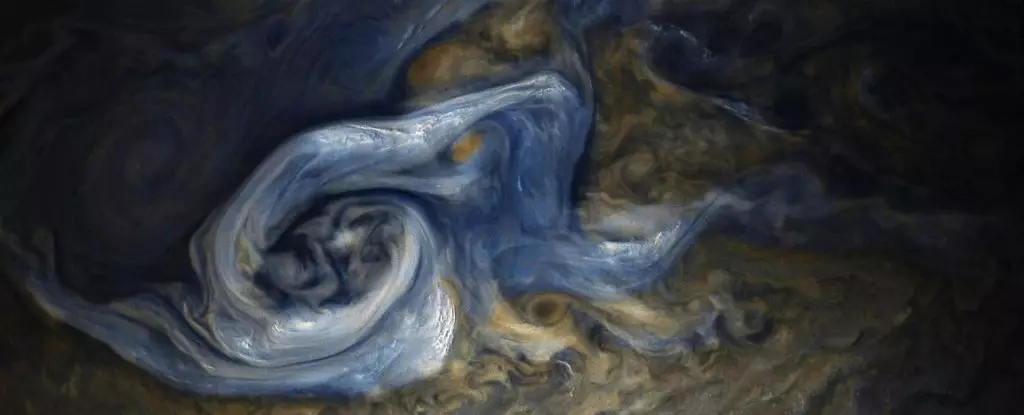Jupiter, the largest planet in our solar system, boasts a tempestuous atmosphere that has captivated astronomers for centuries. Its swirling storms, immense size, and vivid colors provide a constant source of intrigue. Yet, the complexity of its weather often evades straightforward explanation. Recent research has unveiled a surprising phenomenon: the presence of “mushballs” — icy clumps made from water and ammonia — that rain down during Jupiter’s colossal storms. This groundbreaking revelation opens new avenues for understanding Jupiter’s atmospheric conditions and challenges many previous assumptions about not just this gas giant, but potentially all giant planets in our solar system.
The Enigma of Jupiter’s Atmosphere
At first glance, one might assume Jupiter’s atmosphere to be a chaotic, uniform expanse of gas. However, scientists have long noted a puzzling patchiness in ammonia distribution, which lies at the heart of understanding the planet’s weather systems. Recent studies by planetary scientists, including Chris Moeckel from the University of California Berkeley, have revealed an intricate mechanism at work: during severe storms, conditions allow for the formation of mushballs that impact the atmospheric composition significantly.
What makes this discovery particularly profound is its departure from traditional atmospheric theories. Rather than merely shifting gases, these mushballs serve as transporters of both water and ammonia deeper into the planet’s atmosphere. They present a paradigm shift in how we interpret the dynamics of not just Jupiter, but also other gas giants like Saturn, Uranus, and Neptune.
The Formation of Mushballs: Science in Action
The genesis of mushballs is a fascinating interplay between extreme atmospheric conditions and chemical reactions. Under severe storm conditions, water vapor is propelled high into the atmosphere, where it interacts with ammonia vapor. As temperatures drop, these elements undergo a phase transformation. Here, ammonia acts as an antifreeze, reducing the melting point of water ice. The result is a unique cloud mixture of ammonia and water that does not exist on Earth.
The implications of this mechanism are profound. It challenges existing paradigms, suggesting that unique weather events can create entirely new materials within a planet’s atmosphere. This discovery was built upon historical data collected by the Juno probe and Hubble Space Telescope, which disclosed the high-altitude dynamics of Jupiter’s atmosphere. The researchers’ efforts to investigate the data resulted in revelations that fundamentally alter our understanding of what lies beneath the visible cloud tops.
Beyond Jupiter: Implications for our Understanding of Giant Planets
If mushball formation is indeed a widespread phenomenon, it begs the question: how does this mechanism operate across the entire spectrum of giant planets? While Jupiter has long been the focus of planetary science, this new hypothesis holds the potential for a broader application. The transport mechanism of mushballs could reveal similar weather patterns on planets we have yet to investigate in detail.
It also raises intriguing possibilities regarding the internal structures of these planets. For example, could the presence of mushballs be a signal of deeper, unexplored layers of planetary atmospheres? As researchers continue to gather data from missions to distant worlds, it’s plausible to think that we might uncover similar processes elsewhere in the cosmos. The richness of this discovery provides a robust framework for future explorations and theories, expanding our excitement for the ongoing study of planetary atmospheres.
Scientific Rigor Meets Awe-Inspiring Discovery
Despite the thrilling implications, it’s essential to remember the rigorous scientific process that underlies these findings. Moeckel initially approached the hypothesis with skepticism, spending three years attempting to disprove the mushball phenomenon. His eventual acceptance of the data demonstrates how scientific inquiry navigates the delicate balance between skepticism and discovery. The findings are not merely speculative; they are based on robust observational methodologies and data analyses.
As scientists continue to fine-tune their understanding of Jupiter’s atmosphere and the mechanics of mushball storms, they also illuminate the intricate relationships between chemistry and weather phenomena. These studies remind us of the complexity and unpredictability of planetary systems while inspiring wonder in their beautiful intricacies.
Jupiter may seem like an exotic and distant world, but the secrets hidden within its clouds remind us of the interconnectedness of the universe. Engaging with these phenomena allows us to draw connections between our terrestrial experiences and the grander dynamics at play in celestial bodies. The atmosphere of Jupiter is a reminder that, even at great distances, the cosmos holds surprises that challenge our understanding and grow our appreciation for the scientific journey ahead.

